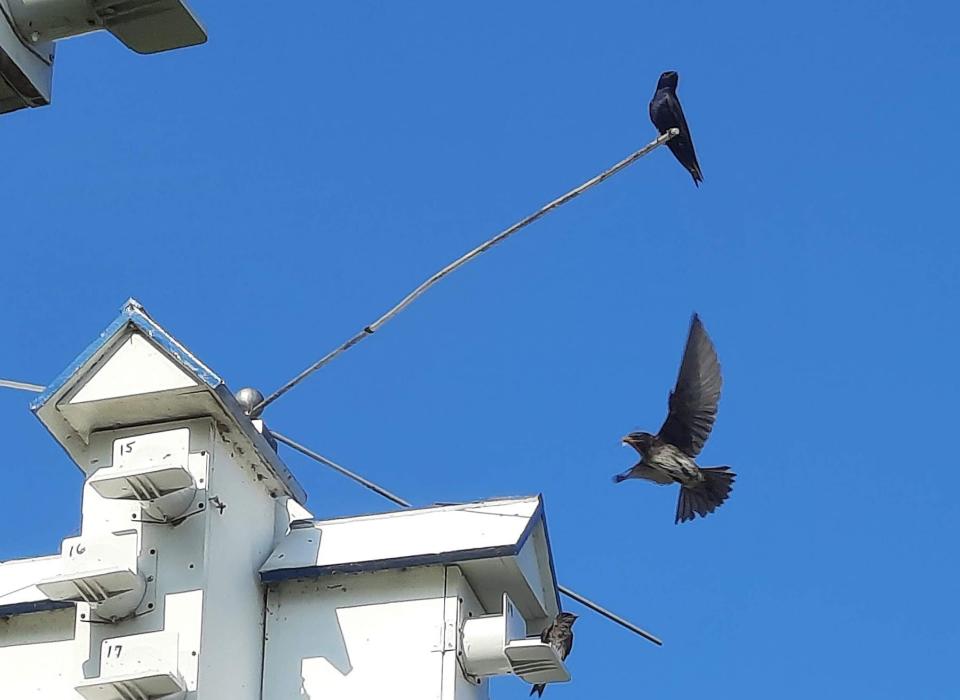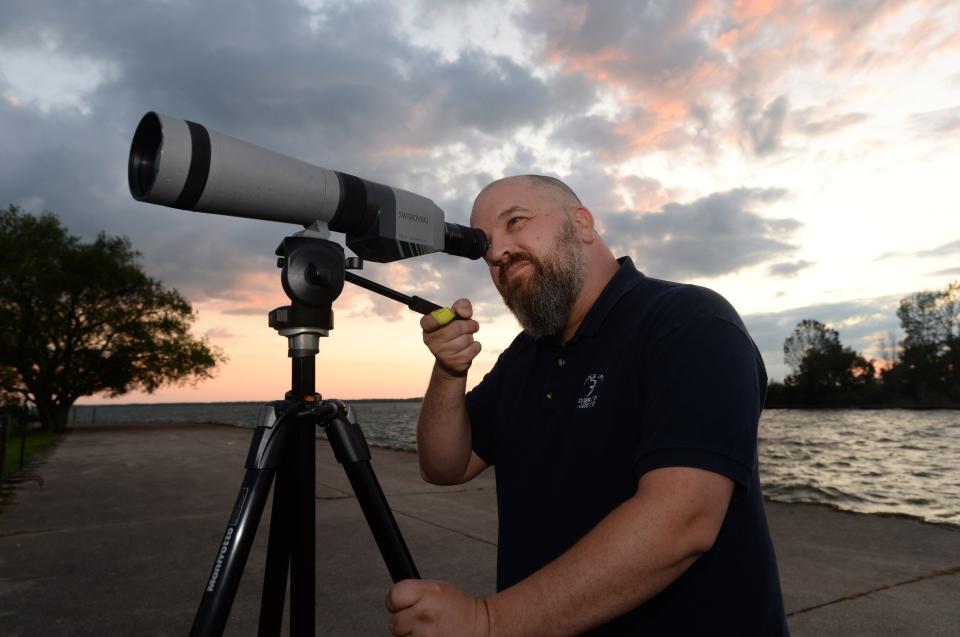Purple martins in Pa. are about to migrate. See them by the tens of thousands at this site
Now is the time in Pennsylvania to watch thousands of purple martins gather in massive roosts.
“It’s an incredible sight. A lot of people consider it one of the most amazing things they’ve ever seen. That’s not as much hyperbole as you might assume. It’s actually an incredible sight,” said Joe Siegrist, president and CEO of the Purple Martin Conservation Association, based in Erie County.
Purple martins are the largest swallows in North America at about 7½ inches long and with a 15-inch to 16-inch wingspan. They migrate each fall to Brazil and return to their same nesting site locations each spring to breed.
“What strikes me the most when I’m at a purple martin roost is the fact that every one of those purple martins that’s in the sky in the tens of thousands or even hundreds of thousand, all exist thanks to people who have cared enough to put purple martin houses in their backyards,” Siegrist said in a telephone interview.
The species has little natural breeding habitat left in a range that largely stretches from the central Canada south through the mid-Plains to Texas and to the East Coast, plus the West Coast shore and some locations in the Southwest, according to the Cornell Lab of Ornithology. In the Midwest and East, martins rely on people for shelter.
“They only can reproduce in birdhouses that people put in their backyards,” Siegrist said. “It’s people who are keeping this species alive, keeping it from extinction. Those purple martin roosts, when you see all these birds in the sky at one time, is a testament to the efforts and care that people put into conserving the species."

Rough spring in Erie County
Even though there are a lot of purple martins in Erie County now, this past spring was challenging for birds that had just traveled thousands of miles. “We had some late winter weather, extending cold rain at the end of April, and that killed a lot of the adults that arrived in our region," Siegrist said.
Cold is detrimental to purple martins, which get all of their food and water in flight. When the temperature drops and there’s cold, rainy weather, there are fewer insects for martins to eat. “They just flew back 5,000 miles from the Amazon to set up breeding territories here in the Erie area and they’ve expended all of their fat reserves. All of their insulation and all of their energy reserves were used to power that long flight back. They arrive here with very little tolerance for bad weather conditions and that leads to starvation pretty quickly if they can’t find anything to eat for a few days in a row,” Siegrist said.
Fortunately, Siegrist noted, the migration is a prolonged process. “By design there are birds that will arrive later and fill in for those that we may have lost due to the weather situation.”
He said the research colonies on Presque Isle State Park this summer had mostly full occupancy, with about 15,000 to 20,000 birds now in the area. “It was really a successful breeding season,” he said.
Where to see purple martin roosts in Pennsylvania
“We’re pretty close to the peak right now,” Siegrist said about the bell curve of the migration. Birds from hundreds of miles gather in late summer in roosting areas such as one in Presque Isle Bay, part of Lake Erie.
“We’re lucky enough to have one of those here in Erie that has reformed here after moving around for several years,” he said.
“They show up right at sunset. Right at (7:45 p.m.) or so is when you’ll want to be there to see them, and the show goes on until it’s too dark to see. The roost will be active for the next several weeks, but it will slowly start to decrease in numbers as we get into September. By mid-September or so, everybody will have been on their way down to Brazil.”
The best place to see the phenomenon at Presque Isle State Park is from Vista 1, or the first parking area, looking out over the bay. “You’ll see them show up in small numbers at the beginning and eventually you’ll look up and the entire sky will be full of them. It’s pretty amazing to see,” Siegrist said.
The birds from the Erie region travel straight south in Pennsylvania on their way toward the Gulf states.
“They don’t go in an orderly migration pathway,” Siegrist said about birds coming from differing roosting areas.
East Coast birds will follow the coast to Florida. In New Jersey, he said there’s a roosting area along the Maurice River, a Delaware Bay tributary, where there are hundreds of thousands of purple martins including some drawn from eastern Pennsylvania.
Large deer population: Why does this deer expert think Pennsylvania hunters are in for banner seasons?
The Pennsylvania Game Commission also monitors martins.
“We are in peak migration season for martins, which reach their largest numbers in Pennsylvania between the third week of August and the first week of September,” Stefan Karkuff, avian recovery biologist for the commission, said through email. “Most birds have left the state by the third week of September on their way to wintering grounds in South America.”
Karkuff said the best place in Pennsylvania to see martins during fall migration is Presque Isle State Park, where he, too, estimates there are about 20,000 birds. “In the morning, birds disperse to hunt insects high overhead throughout the day, but come into roost sites every evening, offering onlookers the best opportunity to witness the spectacle. Now is the time to visit Presque Isle, these numbers will start to drop off in the coming weeks.”
There are martins elsewhere in the state, but they are not as abundant. “This year, Moraine State Park in Butler County had reports of over 500 birds as recently as Aug. 22. The majority of migratory martin reports come from northwest and southeast Pennsylvania, where observers find them hawking for insects over large lakes and reservoirs, or perhaps coming into a local roost. Really, any large body of water statewide could host martins during migration, and those places offer the best chance to spot these aerial insectivores during migration,” Karkuff said.

Siegrist advises birders to visit the association’s website to see the premigration roosting map.
In the spring, the website has a migration map tracking martins’ travels so birdhouses can be ready for their arrival. He said the timing is important because conservationists don’t want other birds to occupy the martin birdhouses before the martins arrive in late spring when insects are flying about. European starlings and house sparrows are especially aggressive nest site thieves, according to the Cornell Lab of Ornithology.
Drone floating on Lake Erie: Uncrewed vessel is surveying Lake Erie for the first time. What researchers hope to learn.
The same martins will use the same birdhouse multiple years, which makes it appealing to bird lovers. “It’s familiar faces. Folks get really excited and anxious for their birds to return every spring,” Siegrist said.
Learn more about purple martins
The Purple Martin Conservation Association will screen a documentary, “Purple Haze,” at 6 p.m. Sept. 16 at the Tom Ridge Environmental Center in Erie. “It’s a really fun, really informative nature documentary that was filmed in part here in Erie,” he said.
Visit purplemartin.org for ticket information and additional details.
Brian Whipkey is the outdoors columnist for USA TODAY Network sites in Pennsylvania. Contact him at bwhipkey@gannett.com and sign up for our weekly Go Outdoors PA newsletter email on this website's homepage under your login name. Follow him on Facebook @whipkeyoutdoors, X @whipkeyoutdoors and Instagram at whipkeyoutdoors.
This article originally appeared on The Daily American: Where can I see purple martins in Pennsylvania?

